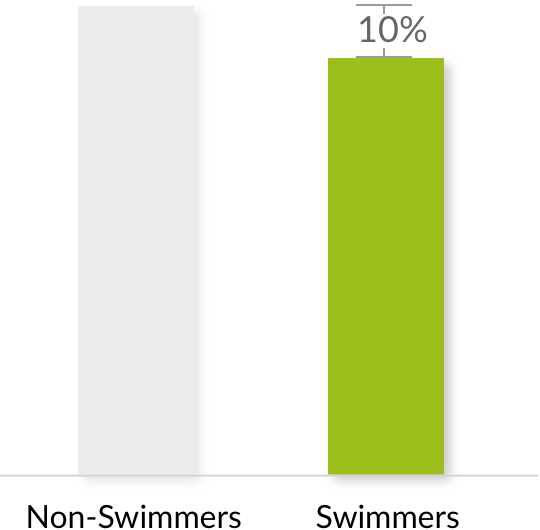
 Swimmers & All-Cause Mortality
Swimmers & All-Cause Mortality
A cohort study of over 80,000 middle-aged people found that swimming provides a 28% reduction in all-cause mortality.
The 2017 study, published in the British Journal of Sports Medicine, studied the associations of six different types of sport/exercise with all-cause and cardiovascular disease (CVD) mortality risk in a large pooled Scottish and English population-based cohort of 80 306 individuals (54% women; mean±SD age: 52±14 years). Selection of covariates was guided by previous literature adjustments made for age, sex, long-standing illness, alcohol drinking frequency, psychological distress, BMI, smoking status, education level, doctor-diagnosed CVD (all-cause mortality analyses only) and weekly physical activity volume (MET-hours/week excluding the volume of the sport that was the main exposure in the corresponding model). Participants who had doctor-diagnosed CVD at baseline (angina, stroke, IHD) were excluded from the analyses with CVD mortality as outcome. Cox proportional hazards regression was used to investigate the associations between each exposure and all-cause and CVD mortality and after adjustments, swimming participation was associated with a significantly reduced risk of all-cause mortality of 28% compared with no participation.
Oja et al Br J Sports Med (2017)

Swimmers & All-Cause Mortality
A cohort study of over 80,000 middle-aged people found that swimming provides a 28% reduction in all-cause mortality.
The 2017 study, published in the British Journal of Sports Medicine, studied the associations of six different types of sport/exercise with all-cause and cardiovascular disease (CVD) mortality risk in a large pooled Scottish and English population-based cohort of 80 306 individuals (54% women; mean±SD age: 52±14 years). Selection of covariates was guided by previous literature adjustments made for age, sex, long-standing illness, alcohol drinking frequency, psychological distress, BMI, smoking status, education level, doctor-diagnosed CVD (all-cause mortality analyses only) and weekly physical activity volume (MET-hours/week excluding the volume of the sport that was the main exposure in the corresponding model). Participants who had doctor-diagnosed CVD at baseline (angina, stroke, IHD) were excluded from the analyses with CVD mortality as outcome. Cox proportional hazards regression was used to investigate the associations between each exposure and all-cause and CVD mortality and after adjustments, swimming participation was associated with a significantly reduced risk of all-cause mortality of 28% compared with no participation.
Oja et al Br J Sports Med (2017)
 Swimmers & Vascular Function
Swimmers & Vascular Function
According to a 2016 study in the American Journal of Cardiology, regular swimming can provide improved vascular function and significantly decreased carotid artery stiffness and inflammatory markers.
This study was designed to test if swimming benefited vascular function and inflammation, specifically in people with osteoarthritis (OA), as compared to the known benefits of cycling. People with OA often have an increased risk of developing cardiovascular disease. Forty-eight middle-aged and older patients with OA were randomly assigned to swimming or cycling training groups. After 12 weeks of supervised exercise training, central arterial stiffness decreased significantly after both swimming and cycling training & vascular endothelial function increased significantly after swimming but not after cycling training. Both swimming and cycling interventions reduced interleukin-6 levels. The researchers concluded that regular swimming exercise can exert similar or even superior effects on vascular function and inflammatory markers compared with land-based cycling exercise in patients with OA.
Alkatan et al. Am J Card (2016)

Brachial-flow mediated dilation
 Swimmers & Heart Performance
Swimmers & Heart Performance
According to a 2013 literature review in International Journal of Cardiology, swimming recreationally can result in an 18% increase in peak left ventricular end-diastolic volume and an 8% increase in peak systolic blood pressure.
This article reviewed the physiologic effects and cardiovascular responses to swimming, the cardiac adaptations to swim training, swimming as a cardiac disease risk factor modifier, and the effects of swimming in those with cardiac disease conditions such as coronary artery disease, congestive heart failure and the long-QT syndrome. In the particular study noted, swimming was also found to improve bicycle exercise performance with VO2 Max increasing by 16% in 12 sedentary middle-aged persons.
Lazar JM et al; Int J Cardiol. 2013 Sep 20;168(1):19-26. (doi: 10.1016/j.ijcard.2013.03.063.)

Swimmers & Heart Performance
According to a 2013 literature review in International Journal of Cardiology, swimming recreationally can result in an 18% increase in peak left ventricular end-diastolic volume and an 8% increase in peak systolic blood pressure.
This article reviewed the physiologic effects and cardiovascular responses to swimming, the cardiac adaptations to swim training, swimming as a cardiac disease risk factor modifier, and the effects of swimming in those with cardiac disease conditions such as coronary artery disease, congestive heart failure and the long-QT syndrome. In the particular study noted, swimming was also found to improve bicycle exercise performance with VO2 Max increasing by 16% in 12 sedentary middle-aged persons.
Lazar JM et al; Int J Cardiol. 2013 Sep 20;168(1):19-26. (doi: 10.1016/j.ijcard.2013.03.063.)
 Swimmers & Cholesterol
Swimmers & Cholesterol
According to a 2009 research review in the Journal of Sports Medicine, swimming results in a 10% decrease in total & LDL cholesterol.
Generally, cross-sectional studies report that middle-aged and older swimmers demonstrate lower total cholesterol as well as low-density lipoprotein cholesterol (LDL-C) values than their sedentary counterparts, and in some cases the values are even lower than the age-matched runners. The lower total cholesterol and LDL-C concentrations are not typically observed in land-based exercise-trained athletes and appear to be unique to swimmers. The authors of the review comment that these cross-sectional studies need to be confirmed with a randomized, controlled, interventional study, but that their own short-term swim training study done in 1997 exhibited a trend for total cholesterol and LDL-C to decrease by »10% following the training in obese hypertensive subjects.
Tanaka H, Sports Med 2009; 39 (5): 377-387 (doi: 10.2165/00007256-200939050-00004)

Swimmers & Cholesterol


We are a licensed life insurance agent* in all 50 states.
View our licenses
We negotiated lower rates on life insurance using science and data.
View our research
By swimmers for swimmers. Our team is comprised of health conscious people who overcame their own health challenges with healthy habits, exercise, and nutrition.
Meet our team
















